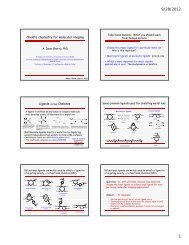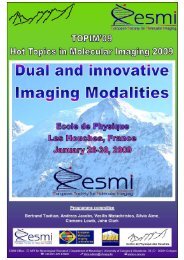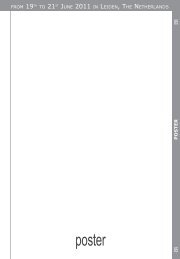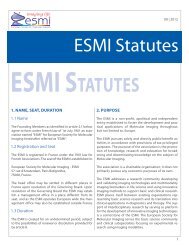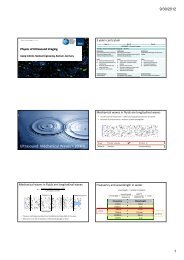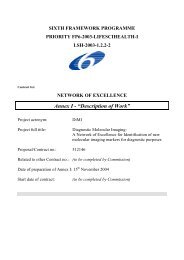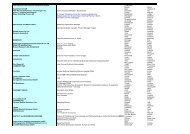5th EuropEan MolEcular IMagIng MEEtIng - ESMI
5th EuropEan MolEcular IMagIng MEEtIng - ESMI
5th EuropEan MolEcular IMagIng MEEtIng - ESMI
Create successful ePaper yourself
Turn your PDF publications into a flip-book with our unique Google optimized e-Paper software.
<strong>5th</strong> <strong>EuropEan</strong> <strong>MolEcular</strong> <strong>IMagIng</strong> <strong>MEEtIng</strong> – EMIM2010<br />
Standardization of molecular PBCA-microbubbles for routine use<br />
Fokong S. , Liu Z. , Gätjens J. , Kiessling F. .<br />
Helmholtz Institute, Aachen, Germany<br />
sfokong@ukaachen.de<br />
Introduction: To develop standardized highly monodisperse<br />
targeted polybutylcyanoacrylate (PBCA)microbubbles<br />
for contrast enhanced molecular<br />
ultrasound imaging.<br />
Methods: PBCA-microbubbles were produced by<br />
mechanical agitation and size isolated by centrifugation.<br />
Physical parameters of the size optimized<br />
microbubbles and regular (Sonovist) microbubbles<br />
were compared. Targeting of the microbubbles for<br />
molecular imaging was achieved by covalently binding<br />
streptavidin molecules onto the shell of surface<br />
activated PBCA-microbubbles and the subsequent<br />
attachment of biotinylated markers. The amount of<br />
targeting ligands on the surface of the microbubbles<br />
was quantified using a fluorescence activated cell<br />
sorter (FACS). The suitability of these microbubbles<br />
for destructive imaging methods like power Doppler<br />
ultrasound, used for the evaluation of the degree of<br />
angiogenesis and the effect of antiangiogenic therapy,<br />
was investigated in gelatin phantoms.<br />
Results: Following a new protocol for the synthesis<br />
of PBCA microbubbles, highly monodisperse populations<br />
could be isolated. Curves obtained from<br />
particle sizer measurements showed size isolated<br />
microbubbles which are normally distributed with<br />
a narrower standard deviation (> 97% ± 1.0-3.0 µm)<br />
in comparison to regular Sonovist microbubbles<br />
(> 97% ± 0.2–10 µm). The high monodispersity was<br />
also confirmed by SEM (scanning electron microscopy)<br />
pictures. The population distribution remained<br />
constant even with prolonged storage in solution<br />
(over 4 months), indicating high stability. Comparison<br />
of the resonance frequencies and the persistence<br />
in an ultrasound field showed a significantly lower<br />
resonance frequency and a lower persistence in the<br />
ultrasound field for the monodispersed microbubbles<br />
compared to the polydispersed microbubbles.<br />
The high monodispersity was maintained even with<br />
covalent coupling of streptavidin molecules onto the<br />
shell of the microbubbles. A quantification of the<br />
number of streptavidin molecules on the surface by<br />
the use of a FACS gave approximately 2 x 10 4 streptavidin<br />
molecules per microbubble. This number can<br />
be tuned according to the degree of surface activation<br />
of the microbubbles. Destructive imaging using<br />
SPAQ (Sensitive Particle Acoustic Quantification)<br />
[1] was also possible with these monodispersed microbubbles<br />
showing a highly reproducible destruction<br />
with high mechanical index ultrasound waves.<br />
Conclusions: Size optimized non modified PBCAmicrobubbles<br />
are more suitable for use as ultrasound<br />
contrast agents in comparison to regular Sonovist<br />
microbubbles. The simplified synthetic protocol allows<br />
for a speed up in the synthesis and purification<br />
process (6 days vs. 3 h). The low resonance frequency<br />
and persistence lead to more efficient detection using<br />
power Doppler techniques. Also, given the relative<br />
high number of targeting ligands which can be<br />
easily attached to their surface, and the possibility to<br />
efficiently quantify their amounts in a region of interest,<br />
they are very suitable for molecular imaging of<br />
intravascular targets. In summary, the tuned properties<br />
of the microbubbles presented in this study, will<br />
make them very interesting as building blocks for<br />
tailoring of specific contrast agents for ultrasound.<br />
Acknowledgement: This work is supported by the<br />
German Federal Ministry of Education and Research<br />
(BMBF-0315017).<br />
References:<br />
1. M. Reinhardt, P. Hauff, A. Briel, V. Uhlendorf, M. Schirner,<br />
Sensitive particle acoustic quantification (SPAQ),<br />
Investigative Radiology 40 (2005) 2-7.<br />
<strong>EuropEan</strong> SocIEty for <strong>MolEcular</strong> <strong>IMagIng</strong> – <strong>ESMI</strong><br />
P-062<br />
poStEr<br />
PROBE DESIGN



